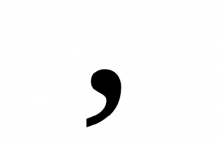The common comma: Part 2

Unwanted commas, or how NOT to use them
Welcome back to the wonderful world of commas! Now that we’ve covered where to put them, let’s look at where they shouldn’t go. Here are six rules to help you avoid unwanted commas:
1. Writing isn’t speech
Don’t put a comma wherever you’d take a breath. Often, unwanted commas creep into writing because we would pause at that place when we speak. While pauses in writing sometimes coincide with a pause in speech, writing operates on its own sets of rules that don’t necessarily reflect speech patterns.
2. Commas stay inside sentences
Don’t use a comma by itself between two independent clauses. (Recall that an independent clause is anything that could stand on its own as a complete sentence.) Using a comma between independent clauses is known as a comma splice.
- Incorrect: Most of the undergraduates gathered in the main hall, Parsifal Persimmon’s gang snuck down to the basement.
3. Commas come before “FANBOYS”
Don’t put a comma after a coordinating conjunction joining two independent clauses. (Recall the FANBOYS—for, and, nor, but, or, yet, so). The comma goes before the conjunction.
- Incorrect: Most of the undergraduates gathered in the main hall but, Parsifal Persimmon’s gang snuck down to the basement.
Note this . . . if you join two coordinated words or phrases with “and, or, but,” don’t add a comma.
- Incorrect: The two ancient enemies paced toward each other warily, and then raised their wands high above their heads. (the element after “and” is a phrase, not an independent clause, because it lacks a subject)
4. No commas between basic sentence parts
Don’t put a comma between basic elements that make up a clause, such as subjects and predicates or verbs and objects.
- Incorrect: Tramping endlessly through the vast moors without a single hour of rest, was exhausting for the children. (subject/predicate split)
- Incorrect: It took Natalia many days to realize, that she would never be able to discover the hidden scrolls without help. (verb/object split)
5. No commas for essential information
Remember the rule about using commas around non-restrictive elements (appositives or relative clauses)? Here’s the opposite: if a phrase or clause is essential for the sentence to make sense or be meaningful, it is restrictive and is not set off with commas.
- Correct: Students who forget to set their alarms may miss their early morning exams. (The relative “who”-clause is restrictive; in relation to this sentence at least, only students who forget to set their alarms might miss the exam--no other students.)
- Incorrect: Students, who forget to set their alarms, may miss their early morning exams. (These commas convey the wrong impression that the “who”-clause is optional or additional information about students in general.)
Think comma placement doesn't really matter? Incorrect use of commas could get you sued! You may want to read about the case of “The $2 Million Comma”: http://www.nationalpunctuationday.com/globe-and-mail.html (Because the contentious phrase was set off with two commas, it was considered non-essential. This is why Rogers lost out.)
6. No comma before “because”
Don’t put a comma before a “because”-clause or any other dependent clause that follows a main clause.
- Incorrect: It is unlikely the federal government will pass Bill C-1,000,090 before the next election, because Parliament will rise before summer.
- Incorrect: Natalie always feels nervous before flying, when the weather is wet and gloomy.
A comma correctly follows an dependent clause when it’s an introductory element.
- Correct: Because Parliament will rise before summer, it is unlikely Bill C-1,000,090 will pass before the next election.
- Correct: When the weather is wet and gloomy, Natalia always feels nervous before flying.
And two more
Here are two more excellent reasons why it’s good to know when not to use commas:
To avoid confusing the heck out of your reader
Leonora walked on her head, a little higher than usual. (Lynn Truss--Eats, Shoots and Leaves, p. 98)
(Should read: Leonora walked on, her head a little higher than usual)
To save lives
Let’s eat, Grandpa.
(This is an invitation to your Grandpa to come eat)
Let’s eat Grandpa.
(This is an invitation to eat your Grandpa)
Enough said.
More resources
You can find a concise guideline for comma use at http://leo.stcloudstate.edu/punct/comma.html
This classic website is packed with self-study quizzes. Try this one for commas: http://grammar.ccc.commnet.edu/grammar/quizzes/comma_quiz.htm

